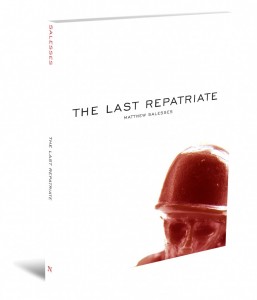Five Questions with Matthew Salesses
Sophie Rosenblum: With a novella, two chapbooks, flash fiction, and several longer stories published or forthcoming, you seem to have a real range of forms. Do you decide beforehand what length you’re going to aim for when you write, or does that figure in once you’ve already begun drafting? What is the difference, say, between working on a novella and working on a piece of flash fiction?
Matthew Salesses: Before I start something, I usually have a general sense of how long it will be, though this can change as I write. I actually wrote the story of Corporal Dickenson (his real-life name) first as a short story, then as a screenplay, then as the novella. I kept feeling like the story needed more room to breathe. When I approached it as a short story, I focused on one aspect, the romance with Kate. There was no love triangle, the scenes in the prison camp were all in flashback, and the key was how the war and his status in it affected his new relationship. In many ways, the story was an experiment of voice. In the novella, the focus is broader, more of an exploration of heroism and the lasting effects of trauma. The plot is more filled-in and everything happens in the present of the story and the voice is more like the lens of a camcorder, moving in and out.
 Re: flash, I write a lot of it, but I often feel dissatisfied with the “size” of the arc. So I’ve found myself writing a lot of linked flash, like in Our Island of Epidemics. I like the idea of smaller arcs that add up to a larger arc. With the shorts in NANO, those are actually two from a larger project–currently over 100 one-page stories that each have their own shape but also swell into a bigger picture. I also like novels that work this way, though in the novel I’m finishing, it’s an opposite case. I challenged myself to write something that couldn’t be taken apart, where the sections only built and built, never stood on their own. Maybe I just like challenges.
Re: flash, I write a lot of it, but I often feel dissatisfied with the “size” of the arc. So I’ve found myself writing a lot of linked flash, like in Our Island of Epidemics. I like the idea of smaller arcs that add up to a larger arc. With the shorts in NANO, those are actually two from a larger project–currently over 100 one-page stories that each have their own shape but also swell into a bigger picture. I also like novels that work this way, though in the novel I’m finishing, it’s an opposite case. I challenged myself to write something that couldn’t be taken apart, where the sections only built and built, never stood on their own. Maybe I just like challenges.
SR: We at NANO Fiction love stories that are under 300 words. As a NANO Fiction contributor and prolific flash fiction writer, what advice do you have for people writing in this form? Are there any essential rules that you follow?
MS: Rules are great, but they’re never essential.
I think that the turn of the sentence in a story of that length can do the work of the turn in a longer story. I like when something happens within each sentence, within the language or within the action or idea of the sentence. I like when a sentence is an action itself, when it takes us from its starting point to somewhere unexpected. So that on a smaller scale you get what I’m talking about above. Small arcs in sentences that give the reader the sense of a greater expansiveness.
The only real advice I can offer is to make use of titles. Something I like to tell my students is that the title of a flash piece can be something left out of the story. Something that opens the story up, or clarifies it. It shouldn’t just be a label. It should do some serious work.
SR: You once wrote on Twitter, “If I were meeting me someplace and were running late, my question to myself would be: which bookstore are you waiting in?” What does the perfect day look like for Matt Salesses?
MS: The perfect day would start and end with my baby sleeping at normal times. The perfect day would involve books. The perfect day would involve writing. The perfect day would involve good food with my wife and probably the beach, and a bath. I haven’t ever had a perfect day, I guess. Is there somewhere I can raise funds for that sort of thing?
SR: Tell us a little bit about your work at The Good Men Project. You’ve mentioned that the goal is getting men to read. What does that goal mean to you personally? If you could see any man read any book, who would it be and why?
read. What does that goal mean to you personally? If you could see any man read any book, who would it be and why?
MS: As we all know, men read far less than women. This is stupid and frustrating. But there’s no one to direct my anger at. I just try to put out the best work possible for the widest audience, and sometimes this works in increasing an author’s readership and sometimes it doesn’t. Men are a hard-headed bunch. If I could get any man to read any book, it would perhaps be Housekeeping. I would get him past those hard first 50 pages into the quiet insistent lull of that story of women and transience, and maybe he would want to read more books that went on turning the gears inside him until something changed.
SR: What can we expect next from Matt Salesses?
MS: Right now I’m plugging away at this book of connected flash/prose poetry–I’m calling it “lyric fiction,” anyone, anyone? And then there’s a novel, The Hundred-Year Flood, about an American who goes to Prague and gets trapped in a flood with the wife of a famous artist. Of course he’s in love with her and the city and, in a way, the artist. I’m still looking for that perfect connection that ends in books.
